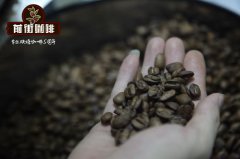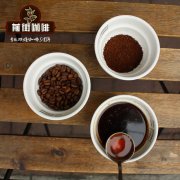Knowledge of Italian Coffee | what is Ristretto and how to extract extra strong Italian Ristretto

Search the Internet for "what is espresso?" You can find a lot of definitions of "espresso" (Ristretto), but generally speaking, espresso is "espresso that is limited or restricted in some way".
The methods of limiting Italian enrichment, why a particular method is chosen, and the final results are varied. This is the theme of today's article: testing the production methods and choices of different espresso.
To this end, we are honored to have colleagues from the School of Chemistry at the University of Newcastle, including Dr. Ian van Altena and Dr. Steve Beveridge. With their help, we analyzed the caffeine extraction rate and TDS (total soluble substances, including sugars, oils and acids) for making 60ml double espresso, and that this method can produce espresso that meets the desired goals.
We experimented with three different kinds of coffee from different producing areas, including Colombia, Ethiopia and Sumatra, and took samples 3 seconds before coffee extraction.
After analysis, we found that the caffeine extraction rate of the three producing areas and its reaction in TDS were very stable, and the caffeine concentration and the total amount of soluble substances were the highest in the first 3 seconds.
The TDS ratio and caffeine content of double espresso are the same at the same time.
This means that we can better explain to baristas and coffee lovers why we choose espresso and answer the following questions:
1. What on earth is espresso?
Why choose it?
Joe Le Mura, a judge of the International Certified baristas Competition and product and technical manager of Bombora Coffee & Water Supplies, said: "the meaning of the word & # 39 is limited. I choose this kind of coffee because I like its rich, full taste and rich flavor, which can bring out the unique quality of some individual coffee. "
The precise method of making espresso can make espresso very delicious, but in fact, many people are not very clear about how it is made. "I personally stick to the 1:1 ratio of coffee to water," Mura said. I will use 22g VST powder bowl, and I like to make the extraction time longer, so I will pay special attention when pressing the powder, control the flow rate, and avoid excessive extraction caused by being too slow. " But Mura also said that there is no set rule on how to make espresso. "it all depends on personal preferences and the experience, skill and knowledge of baristas."
If there are no rules, should we delve into the practice of this kind of coffee? "of course," Mura said. Just as there are differences in espresso practices, baristas should learn the differences between different coffees, such as whether a mix or a single product is more suitable for making espresso. Baristas must grasp the line between right and wrong and work in a more correct direction. "
two。 How to make espresso?
Different production methods will produce different tastes and caffeine levels. Although there was only one practice when espresso first appeared, with the evolution of history, that single practice has long been forgotten. Today, we share with you three popular espresso practices:
1. Cutting method (The Cut-off Ristretto)
To make a single or double espresso, choose the normal amount of coffee powder and then "cut" it manually or automatically before the normal espresso process is completed (usually half).
This is the most commercial approach, and the espresso machine can be done automatically. And through experiments, we found that this method of coffee has higher caffeine content and stronger flavor.
two。 Precision method (The Selective Ristretto)
To make single or double espresso, cut exactly half the amount of espresso.
You can imagine how difficult it is to do this in a busy coffee shop. But the data show that this method makes caffeine and soluble substances distributed more evenly and tastes more silky, but the overall total amount of caffeine and soluble substances is lower, especially much lower than the "cutting method". If you don't want to eat too much caffeine, this is a better choice.
3. Syrup process (The Syrupy Ristretto)
The last method, which is rare in commercial use, requires strict control of water flow by increasing the amount of powder and pressing power, or by using more fine coffee powder. The extraction rate of coffee made by this method is slower, and the overall time is similar to that of ordinary espresso. This method requires a lot of effort from baristas, but the coffee tastes like syrup and can be enjoyed without adding milk or water.
The data show that because of the slower flow rate, according to our inference from the first two methods, the coffee produced by this method should be higher in caffeine, thicker in taste and richer in flavor. However, due to the controlled flow rate, espresso may be produced before 20-40ml or even 10ml compared with ordinary 60ml espresso, so the overall content of caffeine and soluble substances may be lower.
Text | Crema Coffee Garage
Important Notice :
前街咖啡 FrontStreet Coffee has moved to new addredd:
FrontStreet Coffee Address: 315,Donghua East Road,GuangZhou
Tel:020 38364473
- Prev

Coffee knowledge | what exactly does "clean" mean in coffee roasting?
How to understand cleanliness in roasting in coffee roasting class, I keep talking about how to find clean baking, which is actually the most direct description of the preparation of different drinks and the evaluation criteria of coffee beans used in production, so students always ask me, what does clean baking mean? Today, I would like to explain it in a more specific and visual way through this article, because when talking about
- Next

Coffee cherries are covered with treasures. What is coffee peel tea? Can you drink the peel?
What is coffee peel tea? Can you drink the peel? The word "coffee peel tea" comes from Spanish, meaning shell, fruit shell. It was popular in Bolivia and Yemen at first. In recent years, with the in-depth development of coffee culture, coffee peel tea has gradually appeared on the market. Is it tea? No, it belongs to Coffee, not Camellia. Is it coffee? Also
Related
- Beginners will see the "Coffee pull flower" guide!
- What is the difference between ice blog purified milk and ordinary milk coffee?
- Why is the Philippines the largest producer of crops in Liberia?
- For coffee extraction, should the fine powder be retained?
- How does extracted espresso fill pressed powder? How much strength does it take to press the powder?
- How to make jasmine cold extract coffee? Is the jasmine + latte good?
- Will this little toy really make the coffee taste better? How does Lily Drip affect coffee extraction?
- Will the action of slapping the filter cup also affect coffee extraction?
- What's the difference between powder-to-water ratio and powder-to-liquid ratio?
- What is the Ethiopian local species? What does it have to do with Heirloom native species?

